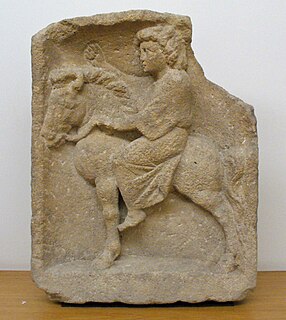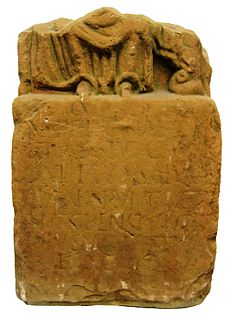Inciona is a little-known Celtic goddess of the Treveran region. Her name is recorded as one of a pair of deities on two votive inscriptions from Luxembourg.
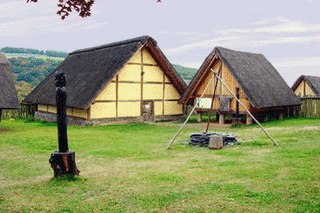
The Treveri or Treviri were a Belgic tribe who inhabited the lower valley of the Moselle from around 150 BCE, if not earlier, until their displacement by the Franks. Their domain lay within the southern fringes of the Silva Arduenna, a part of the vast Silva Carbonaria, in what are now Luxembourg, southeastern Belgium and western Germany; its centre was the city of Trier, to which the Treveri give their name. Celtic in language, according to Tacitus they claimed Germanic descent. Modern historians consider the Treveri to have been a mixed Gallic-Germanic tribe.

Luxembourg, officially the Grand Duchy of Luxembourg, is a small landlocked country in western Europe. It is bordered by Belgium to the west and north, Germany to the east, and France to the south. Its capital, Luxembourg City, is one of the three official capitals of the European Union and the seat of the European Court of Justice, the highest judicial authority in the EU. Its culture, people, and languages are highly intertwined with its neighbours, making it essentially a mixture of French and German cultures, as evident by the nation's three official languages: French, German, and the national language, Luxembourgish. The repeated invasions by Germany, especially in World War II, resulted in the country's strong will for mediation between France and Germany and, among other things, led to the foundation of the European Union.
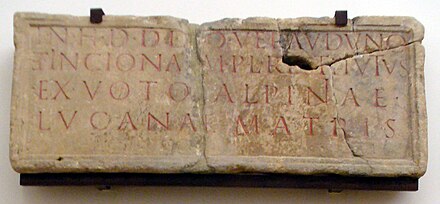
On the large stone slab from Mensdorf on the Widdebierg, pictured at right, she is invoked along with the god Veraudunus and in honour of the imperial family in fulfilment of a vow made by Marcus Pl(autius?) Restitutus' mother Alpinia Lucana. [1]
Mensdorf is a small town in the commune of Betzdorf, in eastern Luxembourg. As of 2005, the town has a population of 765.
Widdebierg is a hill in the commune of Betzdorf, in eastern Luxembourg. At 386 metres, it is one of the highest points in the canton of Grevenmacher. It is in the centre of a nature reserve, which lies between the towns of Flaxweiler, Mensdorf, and Roodt-sur-Syre.

Veraudunus is the name of a Celtic god known only from two votive inscriptions found in Luxembourg. One of these inscriptions suggests that ‘Veraudunus’ may have been an epithet of the important Treveran god Lenus Mars. In both inscriptions, Veraudunus is invoked along with Inciona.
The second inscription, a small bronze votive plaque from Kaul in Luxembourg, reads:
- [LE]NO MAR[TI]
VERAVDVN(O) ET
INCIONE MI
[L]ITIVS PRIS
CINVS EX VOT(O)
If the letters NO MAR can be restored as Leno Marti, then Inciona is here invoked alongside Lenus Mars Veraudunus. [1]
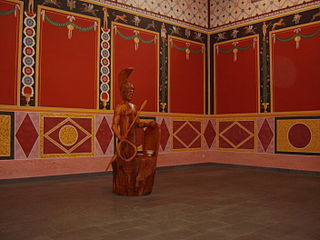
Lenus was a Celtic healing god worshipped mainly in eastern Gaul, where he was almost always identified with the Roman god Mars. He was an important god of the Treveri tribe, who had large sanctuaries at medicinal springs at Trier and the Martberg by Pommern in what is now Germany. Two dedications to him are also known from southwestern Britain. Edith Wightman characterizes him as “one of the best examples of a Teutates, or god of the people, equated with Mars—protector of the tribe in battle, but also [...] bestower of health and general good fortune” (p. 211). His sanctuary ‘Am Irminenwingert’ at Trier had a large temple, baths, smaller shrines and a theatre; that on the Martberg also included a large variety of buildings, probably including rooms for health-seeking pilgrims to stay. Despite his associations with healing, Lenus Mars is depicted classically as a warrior with Corinthian helmet in a bronze statuette from the Martberg.

In ancient Roman religion and myth, Mars was the god of war and also an agricultural guardian, a combination characteristic of early Rome. He was second in importance only to Jupiter and he was the most prominent of the military gods in the religion of the Roman army. Most of his festivals were held in March, the month named for him, and in October, which began the season for military campaigning and ended the season for farming.
